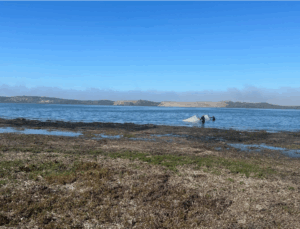Monitoring program successfully demonstrates how to evaluate estuary health statewide

SCCWRP and its partners have successfully demonstrated how a diverse network of monitoring partners can collaboratively implement a newly developed statewide program for monitoring the health of coastal estuaries – a proof-of-concept milestone that paves the way for California to begin producing comprehensive, routine assessments of wetland ecosystem health.
The initial implementation of the California Estuarine Marine Protected Areas (EMPA) Monitoring Program, described in a technical report published in June, showcased how seven partners working in geographically disparate settings with access to different levels of resources and expertise can produce a unified statewide assessment of coastal estuary health. Program participants will build on this demonstration phase as they scale and finalize the program in the coming months.
The monitoring program uses a standardized assessment approach that focuses on the ecological functioning of estuaries. Although this approach is advantageous in that it is directly tied to the beneficial-use goals that estuary managers are working to protect, it also is more complex and laborious to implement than traditional monitoring approaches, which rely on simpler measures of ecosystem condition like the wetland monitoring approach codified into the California Rapid Assessment Method (CRAM).
During the initial implementation of the monitoring program, the network monitored 16 sites statewide, including seven in Southern California, using monitoring methods that were recently standardized and vetted by SCCWRP.
SCCWRP supported the program’s initial pilot monitoring phase by helping to coordinate program participants and managing the program’s data management infrastructure, including a web-based data submission portal and data analysis and visualization tools.
Researchers’ next step is to expand the monitoring to include a larger network of 25 estuary sites, including adding additional partners with more limited resources and monitoring experience.
Once fully developed and implemented in late 2026, the monitoring program will enable researchers to use standardized, rigorously vetted methods for comprehensively assessing the health of wetlands statewide, including assessing the health of the estuaries that have been designated Estuarine Marine Protected Areas (EMPAs). The monitoring program also will be used for evaluating the relative success of different estuary restoration projects and engaging in long-term climate resilience planning.
California has spent more than $600 million over the past two decades to protect and preserve wetlands, but these efforts have largely been site-specific and siloed, with managers lacking rigorous assessment tools and a unified monitoring program through which to assess the effectiveness of management interventions.
Coastal wetlands play a critical role at the land-sea interface, helping to buffer against coastal flooding, filter and retain contaminants, and provide critical habitat for vulnerable plant and animal communities.
A 2017 analysis by SCCWRP and its partners found that about half of the region’s remaining wetlands are expected to become permanently submerged by 2100 as a result of sea level rise. But the news is not all bad: If Southern California realigned levees, roads and other infrastructure, the region has the potential to experience a net gain of up to 4,800 acres of wetlands.
In 2018, the Southern California Wetlands Recovery Project – a consortium of seven State agencies, five federal agencies, and six local agencies – developed a master, long-term strategy calling on the region’s wetlands to be managed as an interconnected, interdependent network, and to build capacity to conduct regional assessments of wetland health.
The consortium is developing a regional estuary monitoring program for Southern California that integrates seamlessly with both California’s EMPA Monitoring Program and the Southern California Bight 2023 Regional Monitoring Program’s Estuaries study element.
For more information, contact Dr. Jan Walker.
More news related to: Climate Change, Regional Monitoring, Sea Level Rise, Top News